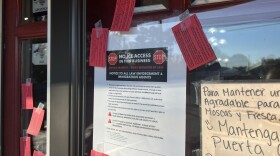Immigration has taken center stage this week with President Obama's announcement of protection for some children and families who entered the country illegally. In North Carolina, some area teachers have recently been trained to better understand the experience of such undocumented immigrants. The training is based on an extraordinary set of photos, taken over two decades, on both sides of the U.S./Mexico border.
WUNC's Carol Jackson tells the story:
Mexico City-based photographer Janet Jarman first met a little girl named Marisol at a municipal dump in Matamoros, Mexico.
"I met Marisol by chance, complete chance," remembers Jarman. "Amid smoke and scorching sunlight and dust. I can barely see these figures in the distance, but I saw a mother with her children, and I approached them. I asked the mother if I could take her picture, and she yelled over to Marisol, 'Let the lady take your picture you might be famous one day!'"
Each day the family would go to the dump to scavenge for recyclables. The children had found awful things there. Human corpses. A fetus. Dead animals. The mother, Eloisa, was desperate to move the family.

Jarman and the family had an instant connection. They brought her to their home which was adjacent to the dump, and Jarman stayed for four days. Jarman had been thinking about doing a longer story on immigration.
"I thought what if I had a family: I could show why people were leaving [Mexico] and what would happen to them once they came to the U.S. -- Wouldn't that be a different, hopefully more profound way of telling [the immigration] story?"

Three months after that initial meeting, Jarman came back to the dump where she'd first met the family. But the house was boarded up and they were gone.
"I thought 'I can't let this go," Jarman remembers. "I want to show more of their life. I have this opportunity and I want to see them again. I really wanted to see them again."
But the family had disappeared. Someone suggested that they had crossed the border to pick strawberries. Jarman figured out where strawberries were in season in the U.S. and she called around, asking questions, eventually tracking the family to Florida.
"I remember that vividly," she says. "I drove and found them. I lived with them for another period of time, they were living in a trailer."
Twelve people were crammed into the trailer, which was located in the middle of a field. At first, it seemed as if the housing was better than their home in Mexico. But the trailer was tiny, and infested with rats. Eloisa and her children felt isolated and homesick for Mexico.

The family moved around the U.S. in search of better opportunities. One of the most powerful images in the series was taken in their backyard in Texas. At first glance it is a hopeful photo. Marisol's sister Kristina and another little girl are touching hands across a fence.
But later, says Jarman, she asked Kristina who the other little girl was.
I said, "Is that one of your good friends?"
She said "Yeah, we meet at the fence. Her parents won't let her come in our yard because we're Mexican."

"I thought the story was over then. With that fence," says Jarman. "Because I thought, 'We've come this far, we've crossed this enormous geographic border, and now we have these social barriers.'"
But the story doesn't end there. Janet Jarman has continued to photograph Marisol and her family - to follow their story - for two decades.
She was in Texas the day the family was evicted from their home. They had paid rent, under an informal rent-to-own program.

"For them, the house had provided the only stability they knew," says Jarman. For their mother, Eloisa, it represented the American dream, of which she felt unjustly robbed. According to documents, Eloisa and Vinicio made rent payments of over $30,000 to a landlord, also from Mexico, after signing an informal rent-to-own agreement with him. When the landlord stopped paying mortgage payments on the house, the bank foreclosed on the property.

Marisol's dream
Janet Jarman lost contact with Marisol for a three-year period. But one day she found her again. Marisol had become pregnant with her first child at age 16.
"I remember the times when Marisol used to tell me in her early childhood that she wanted to be a computer teacher. She wanted to be a lawyer so she could help other immigrants. She wanted to be an artist. She used to paint and really observe her surroundings and interpret them," says Jarman. "And so I listened to all of that and as I watched her life unfold, I watched some of these dreams go away."
"And I think what perplexed me the most is wondering, 'Why are these dreams going away?' Because in a way Marisol, her story is her story; she doesn't represent every immigrant story, but she does represent a lot of girls in her age group who are brought across the border and may not have had a chance to be nurtured in school."
Immigration in North Carolina
Mimi Chapman is an Associate Professor in the UNC School of Social Work. Her specialty is immigration and families. She notes that there has been a 1,000 percent increase in number of Hispanic immigrants to North Carolina since the 1990s. And no matter their legal status, children are allowed to attend area schools.
Chapman first saw the exhibit Marisol: The American Dream at the Ackland Art Museum in Chapel Hill. She envisioned using the photos to help teachers better understand the challenges that many undocumented immigrants face.
"No teacher, no physician, no social worker, without a lot of time can know their students, or clients, the details of their story," says Chapman. "There aren't enough hours in the day, the system isn't structured to do that. So giving them the experience with Janet's photographs, which have this wonderful narrative arc, allows them to get a sense of a full story that may inform their students' stories and help them understand in a real concrete way that there are many, many stories in their classrooms."
Classroom use
Lisa Napp is one of those who has organized such a training, which is conducted by Chapman in partnership with Robert Colby, an art historian and former staff member at the Ackland Art Museum, who is now a visiting research instructor at the UNC School of Social Work. Dr. Napp is Director of Elementary Education, Pre-K, Title I and ESL in the Orange County Public Schools.
"I was hoping that through this workshop the team that came together, the curriculum and instruction team, would have a better understanding of the people we work with, and care for, and care about daily," says Napp.
Janet Jarman has come to think that maybe the most important audience for Marisol's story are teachers.
"I am really grateful for this use of my photographs. It touches on the essence of why I dedicated my career to journalism. I've learned that maybe [teachers are] my audience, if their decisions are making changes in immigrants' lives, then maybe they are the most important audience to reach."
Marisol is now a legal U.S. resident. She is married and her children are doing well in school. Janet Jarman continues to follow the family's progress.










